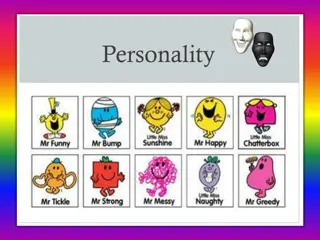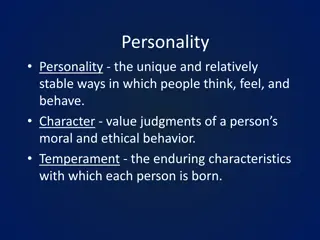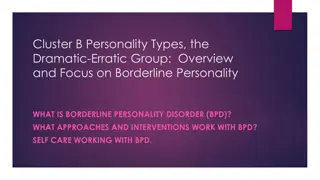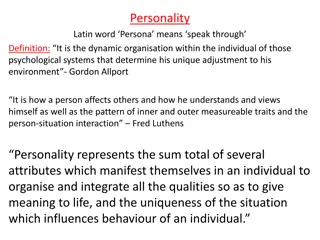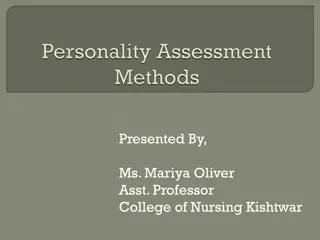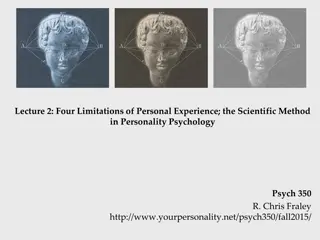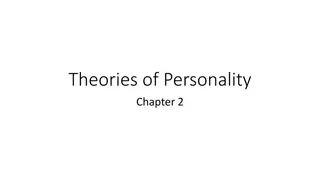Understanding Personality: Theories and Components Explained
Personality is the unique and enduring characteristics that define individuals, influencing their behavior consistently over time. Explore the origins of personality from the Latin word 'persona' meaning 'mask', and delve into major perspectives such as psychoanalytic, trait, humanistic, and social-cognitive theories. Discover how the components of the mind, including the Id, Ego, and Super-Ego, shape human behavior and development according to psychoanalytic theory. Uncover the intricate interplay between unconscious motivations, specific dimensions of personality, inner growth capacity, and environmental influences that contribute to understanding and defining personality traits.
Download Presentation

Please find below an Image/Link to download the presentation.
The content on the website is provided AS IS for your information and personal use only. It may not be sold, licensed, or shared on other websites without obtaining consent from the author. Download presentation by click this link. If you encounter any issues during the download, it is possible that the publisher has removed the file from their server.
E N D
Presentation Transcript
definitions The word'personality' derives from the Latin word 'persona' which means 'mask'. The study of personality can be understood as the study of 'masks' that people wear. Personality refers to the relatively enduring characteristics that differentiate one person from another and that lead people to act in a consistent and predictable manner, both in different situations and over extended periods of time. Personality: A person s unique and relatively stable behavior patterns; the consistency of who you are, have been, and will become.
Four Major Perspectives on Personality Psychoanalytic - unconscious motivations. Trait - specific dimensions of personality. Humanistic - inner capacity for growth. Social-Cognitive - influence of environment.
Theories of personality Psychoanalytic theory: Psychodynamic (Sigmund Freud) Freud s works about the effects of unconscious mind and childhood experiences on personality. According to him, the human behavior is formed through an interaction between three components of the mind, i.e. Id, Ego and Super Ego.
components of the mind Id: Id is the primitive part of the mind that seeks immediate gratification of biological or instinctual needs. The biological needs are the basic physical needs and while the instinctual needs are the natural or unlearned needs, such as hunger, thirst, sex, etc. Id is the unconscious part of the mind; that act instantaneously without giving much thought to what is right and what is wrong
components of the mind Super-Ego: The Super-Ego is related to the social or the moral values that an individual inculcates as he matures. It acts as an ethical constraint on behavior and helps an individual to develop his conscience. As the individual grows in the society, he learns the cultural values and the norms of the society which help him to differentiate between right and wrong.
components of the mind Ego: Ego is the logical and the conscious part of the mind which is associated with the reality principle. This means it balances the demands of Id and super-ego in the context of real life situations. Ego is conscious and hence keep a check on Id through a proper reasoning of an external environment.
Personality development: Freud believed that the basic elements of adult personality are in place by age five and result from the outcome of five psychosexual stages. In each stage, children must cope with distinct immature sexual urges that influence adult personality. Fixation results if the child fails to move forward from one stage to another, and is usually caused by excessive gratification, or frustration of needs at a particular stage.
Libido Libido is a term used by in psychoanalytic theory to describe the energy created by the survival and sexual instincts. According to Sigmund Freud, the libido is part of the id and is the driving force of all behavior. While the term libido has taken on an overtly sexual meaning in today's world, to Freud it represented all psychic energy and not just sexual energy.
Oral stage of development: Time period: Birth to 18 months. Erogenous zone is mouth. mouth Gratification through sucking and swallowing. Oral fixation has two possible outcomes. Oral receptive personality: Preoccupied with eating/drinking. Reduce tension through oral activity. eating, drinking, smoking, biting nails Passive and needy; sensitive to rejection. Oral aggressive personality: Hostile and verbally abusive to others.
Anal stage of development: Time period: 1 1/2 to 3 years of age. Erogenous zone is the anus. Conflict surrounds toilet training. Anal fixation has two possible outcomes. Anal retentive personality. personality Stingy, compulsive orderliness, stubborn, perfectionist. Anal expulsive personality. personality Lack of self control, messy, careless.
According to Freud, success at this stage is dependent upon the way in which parents approach toilet training. Parents who utilize praise and rewards for using the toilet at the appropriate time encourage positive outcomes and help children feel capable and productive. Freud believed that positive experiences during this stage served as the basis for people to become competent, productive, and creative adults. If parents are too strict or begin toilet training too early, Freud believed that an anal-retentive personality develops in which the individual is stringent, orderly, rigid, and obsessive.
The Phallic Stage Age Range: 3 to 6 Years Erogenous Zone: Genitals Freud suggested that during the phallic stage, the primary focus of the libido is on the genitals. At this age, children also begin to discover the differences between males and females. Freud also believed that boys begin to view their fathers as a rival for the mother s affections.
The Oedipus complex describes these feelings of wanting to possess the mother and the desire to replace the father. However, the child also fears that he will be punished by the father for these feelings The term Electra complex has been used to described a similar set of feelings experienced by young girls.
The Latent Period Age Range: 6 to Puberty Erogenous Zone: Sexual Feelings Are Inactive During this stage, the superego continues to develop while the id's energies are suppressed. Children develop social skills, values and relationships with peers and adults outside of the family. The development of the ego and superego contribute to this period of calm. The stage begins around the time that children enter into school and become more concerned with peer relationships, hobbies, and other interests.
The latent period is a time of exploration in which the sexual energy repressed or dormant. This energy is still present, but it is sublimated into other areas such as intellectual pursuits and social interactions. This stage is important in the development of social and communication skills and self-confidence. As with the other psychosexual stages, Freud believed that it was possible for children to become fixated or "stuck" in this phase. Fixation at this stage can result in immaturity and an inability to form fulfilling relationships as an adult.
The Genital Stage Age Range: Puberty to Death Erogenous Zone: Maturing Sexual Interests The onset of puberty causes the libido to become active once again. During the final stage of psychosexual development, the individual develops a strong sexual interest in the opposite sex. This stage begins during puberty but last throughout the rest of a person's life
The goal of this stage is to establish a balance between the various life areas. If the other stages have been completed successfully, the individual should now be well- balanced, warm, and caring. Unlike the many of the earlier stages of development, Freud believed that the ego and superego were fully formed and functioning at this point. Younger children are ruled by the id, which demands immediate satisfaction of the most basic needs and wants. Teens in the genital stage of development are able to balance their most basic urges against the need to conform to the demands of reality and social norms.
Trait Approach to Personality This approach assumes behavior is determined by relatively stable traits which are the fundamental units of one s personality. Traits predispose one to act in a certain way, regardless of the situation. This means that traits should remain consistent across situations and over time, but may vary between individuals. It is presumed that individuals differ in their traits due to genetic differences. These theories are sometimes referred to a psychometric theories, because of their emphasis on measuring personality by using psychometric tests. A person is given numeric score to indicate how much of a trait the they possess.
Eysencks Personality Theory Eysenck (1952, 1967, 1982) proposed a theory of personality based on biological factors, arguing that individuals inherit a type of nervous system that affects their ability to learn and adapt to the environment. Eysenck (1947) found that their behavior could be represented by two dimensions: Introversion / Extroversion (E); Neuroticism / Stability (N). Each aspect of personality (extraversion, neuroticism and psychoticism) can be traced back to a different biological cause. Personality is dependent on the balance between excitation and inhibition process of the autonomic nervous system (ANS).
Extraversion/introversion Extraverts are sociable and crave excitement and change, and thus can become bored easily. They tend to be carefree, optimistic and impulsive. They are more likely to take risks and be thrill seekers. Eysenck argues that this is because they inherit an under aroused nervous system and so seek stimulation to restore the level of optimum stimulation. Introverts on the other hand lie at the other end of this scale, being quiet and reserved. They are already over- aroused and shun sensation and stimulation. Introverts are reserved, plan their actions and control their emotions. They tend to be serious, reliable and pessimistic.
Neuroticism/stability stability A person s level of neuroticism is determined by the reactivity of their sympathetic nervous system. A stable person s nervous system will generally be less reactive to stressful situations, remaining calm and level headed. Someone high in neuroticism on the other hand will be much more unstable, and prone to overreacting to stimuli and may be quick to worry, anger or fear. They are overly emotional and find it difficult to calm down once upset. Neurotic individuals have an ANS that responds quickly to stress.
According to Eysenck, the two dimensions of neuroticism (stable vs. unstable) and introversion-extroversion combine to form a variety of personality characteristics.
Humanistic theories of personality Humanistic theories of personality stress the basic goodness of human beings and the need to achieve ones full potential. Rejected the assumptions of behaviorism and psychoanalytic approach. Two well known psychologists for Humanistic theories; - Carl Rogers Abraham Maslow
Cont, People are motivated to self-actualize: Self-actualization concerns psychological growth, fulfillment and satisfaction in life. Both Rogers and Maslow regarded personal growth and fulfillment in life as a basic human motive. This means that each person, in different ways, seeks to grow psychologically and continuously enhance themselves. However, Rogers and Maslow both describe different ways of how self-actualization can be achieved.
Self-Actualization Rogers followed very similar to the belief s of Maslow Believed that individuals could grow. In order to grow, the environment needs to provide genuineness, acceptance, and empathy. Need to achieve goals, wishes, and desires in life in order to achieve self-actualization
The Fully Functioning Person Once a person was able to self-actualize, Rogers would refer to them as a fully functioning person There are five characteristics of a fully functioning person: 1. Open to experience 2. Existential living 3. Trust feelings 4. Creativity 5. Fulfilled Life
Theory of Personality Defined as the organized, consistent set of perceptions and beliefs about oneself. The self is our inner personality (linked to Freud) Influenced by experiences throughout life Self-concept is influenced by childhood experiences and the evaluation of others Self-concept has three components 1. Self Worth 2. Self-image 3. Ideal Self
Self Worth Also known as self esteem What we think about ourselves Rogers believes that self-worth develops in early childhood Self Worth is influenced by the interactions with our parents
Self-Image How we see ourselves Important to good psychological health Includes the influence of our body image on our inner personality Effects how a person thinks, feels, and behaves in the world
Ideal Self The person we would like to be Consists of our goals and ambitions in life Forever changing
Congruence VS. Incongruence Incongruence When a person s ideal self is not consistent with what happens in their life Congruence When a person s ideal self is consistent to their actual experiences
Abraham Maslow INTRODUCTION Abraham Maslow sought to explain why people are driven by particular needs at particular times. His answer is that human needs are arranged in a hierarchy from most to least processing. People will try to satisfy their most important needs first. When a person succeeds in satisfying an important need, he will then try to satisfy the next important need.
Physiological Needs These are biological requirements for human survival, e.g. air, food, drink, sleep. Maslow considered physiological needs the most important as all the other needs become secondary until these needs are met. Higher needs such as social needs and esteem are not recognized until one satisfies the needs basic to existence. If these needs are not satisfied the human body cannot function optimally. E.g; air, food, drink, shelter, warmth, sex, sleep, etc.
Safety Needs Once physiological needs are met, one's attention turns to safety and security in order to be free from the threat of physical and emotional harm. Such needs might be fulfilled by: Living in a safe area Medical insurance Job security According to the Maslow hierarchy, if a person feels threatened, needs further up the pyramid will not receive attention until that need has been resolved. e.g. home, Helmet, Medicines, security guard for home, security, law, etc.
Love and belongingness needs After physiological and safety needs have been fulfilled, the third level of human needs is social and involves feelings of belongingness. The need for interpersonal relationships motivates behavior. Examples include friendship, intimacy, trust, and acceptance, receiving and giving affection and love. Affiliating, being part of a group (family, friends, work).
Esteem needs Once a person feels a sense of "belonging", the need to feel important arises. Maslow classified into two categories: (i) esteem for oneself (dignity, achievement, mastery, independence) and (ii) the desire for reputation or respect from others (e.g., status, prestige). E.g Some esteem needs are: Self-respect Achievement Attention Recognition Reputation
Self-actualization needs realizing personal potential, self-fulfillment, seeking personal growth and peak experiences. Self-actualization is the summit of Maslow's hierarchy of needs. It is the quest of reaching one's full potential as a person. Unlike lower level needs, this need is never fully satisfied; as one grows psychologically there are always new opportunities to continue to grow. Self-actualized people tend to have needs such as: Truth Justice Wisdom


